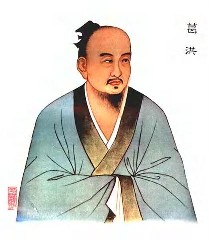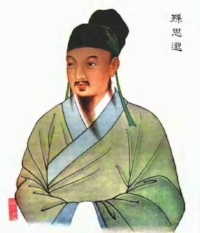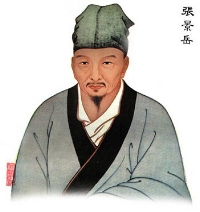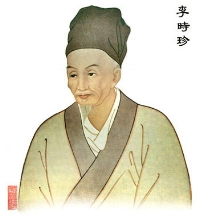History
han
The herbal medicine tradition of the far east can be traced back to the legendary father of agriculture, Shen Nong / 神农, who is said to have lived around (-)2800 and to have introduced concepts of agriculture and herbal medicine into society. The original written compilation of the knowledge within this folk tradition dates back to the Han Dynasty and has been lost to the centuries, but the information in the text is preserved in a book written a few hundred years later by Dao Hongjing / 陶弘景. Dao was an aristocrat born (+) 456 in Moling / 秣陵, not too far from present-day Shanghai. He is an important founding father of the Shang Qing /上清 sect of Daoism which developed in Maoshan, and he authored many works including Shen Nong's Herbal Foundations Classic (Shen Nong Ben Cao Jing) / 神農本草經. This text introduces 365 herbs and their medical and alchemical uses, interactions, and growth habits.
Han Dynasty China also produced another important herbal medicine book called the Treatise on Cold Damage (Shang Han Jia Bing Lun) / 傷寒雜病論, written by Zhang Zhongjing, born (-) 150. This book theorizes a six-stage progression of disease beginning with the invasion of an external (cold) pathogen via the skin or lungs and following the natural history of disease, marking each stage with a set of herbal formulas and a discussion about their use. This book was followed by a sequel called the Essential Prescriptions from the Golden Cabinet (Jin Gui Yao Lue) / 金匱要略 which further expanded theoretical and practical discussion. Both of these texts remain important subjects of study for Chinese medical students and their legacy is vast, containing some of the most important formulas in use today.
Another notable physician practicing during the Han Dynasty was Hua Tuo / 華佗. He lived (+) 140-208 and was from modern day Anhui. Hua is best known for his exploration in surgery and anesthesia and for the development of the formula ma fei san / 麻沸散, used as an general anesthetic. He is famous for having treated the prominent politician and warlord Cao Cao / 曹操, who was the first emperor of the state of Wei during the three kingdoms period and who subsequently had Hua executed. He is also (kind of legendarily) supposed to have treated Guan Yu / 關羽, who was a famous general that was instrumental in the collapse of the Han and the subsequent establishment of the Shu Han state, and who was subsequently deified as a god of righteousness. General Guan was shot with a poisoned arrow in battle and Hua treated him and saved his life.
jin
Ge Hong was a Daoist within the Shang Qing tradition who lived (+) 283 - 343. He was born in Jurong, Jiangsu where he served as a state official for much of his life. He was known for his study of philosophy, medicine, and literature. Ge's contributions to herbalism were mostly within the realm of alchemy. In his books Traditions of Divine Transcendence and The Master Who Embraces Simplicity he outlines alchemical formulas for spiritual cultivation and compiles large portions of the Daoist oral tradition at the time.
tang
Over the years, many different herbal traditions have developed and influenced the way herbal medicine is approached and administered. Tang Dynasty China was a time of great intellectual and cultural growth due to the unification of southern and northern China. During this time we see the emergence of a man who would come to be called the King of Medicine -- Sun Simiao / 孫思邈. Sun was born circa (+) 581 in Shanxi province and over the course of his life came to be the most famous and influential physician in the country, refusing numerous offers to work as imperial herbalist. Sun's legacy is extensive, including the Chinese equivalent to the Hippocratic oath, which is still the pledge taken by new graduates, and the most comprehensive materia medica of Chinese herbs to date called the Essential Formulas Worth a Thousand Pieces of Gold and its sequel. These books describe several thousand herbal formulas and were an effective summary of the pre-Tang Dynasty medical system.
Later, during the (+) 13th-14th centuries we see a great diversification of ideas regarding diagnosis and treatment strategy in medicine. This may have come in part due to the advent of movable type a few centuries prior and the subsequent widespread availability of the medical classics. Such an intellectual wave certainly followed the printing press during the Ming Dynasty.
Jin-yuan
Liu Wansu (1120-1200) established the cooling school which emphasized clearing heat as a strategy. This stemmed from the belief that any pathogenic factor, be it wind, dampness, summer heat, fire, dryness or cold would eventually generate heat if allowed to progress. This heat arises from congestion and constraint which essentially increases resistance within a system and this leads to friction and heat. He leans on herbs like hua shi and gan cao in his most famous formulas to generate fluids and drain fire.
Zhang Zihe (1158-1228) established the school of attacking and purging which held that noxious qi was the root for disease and that this should be treated by methods of catharsis such as sweating, vomiting, or precipitation (elimination via the bowels). His ideas were widely popular during his life and came to be nationally known, but were abandoned in the years to come as the methods came to be recognized as too harsh and potentially damaging to the righteous qi.
Li Dongyuan (AKA Li Gao) lived 1180-1251 and was from Hubei. He established the earth school or the school of tonification. He placed particular emphasis on disease stemming from diet and weakness of the earth element (that's the spleen and stomach). This would relate closely to the idea of fortifying the immune system to prevent disease, and in this way falls right in line with contemporary trends. His strategy relied on tonic herbs like bai zhu, fu ling, and huang qi and the most famous formulas that he developed are bu zhong yi qi tang and sheng mai san.
Zhu Danxi was born Zhu Zhenheng in Zhejiang province in 1281. He developed the understanding that the disease process provoked an overactivity of the fire element and especially disturbed the ministerial fire of the liver and kidneys, leading to the consumption of yin within these organs and eventual decline. As a result of this, he created a school of nourishing the yin, which always protects the yin as a fundamental aspect of treatment. Zhu's strategy called for the frequent use of heavy yin tonics and led to the very popular formula da bu yin wan.
Ming
Zhang Jingyue was born Zhang Jiebin in the 1560's in Zhejiang just as the Ming was giving way to the Qing. He belonged to the school of nourshing yang, which arose in the wake of Li Dongyuan's theories concerning the importance of tonification. Zhang placed particular emphasis on the dynamic of ming men / 命門, the root of yin and yang in the body. He focused on the evaluation and rebalancing of the kidney yin and kidney yang in order to correct the physiodynamics from the root. Di huang is the herb he favored for nourishing kidney yin and fu zi for kidney yang. He authored the formulas famous formulas zuo gui wan and you gui wan. Find more information about Zhang Jingyue here in an article by Subhuti Dharmananda.
Li Shizhen is amongst the most important physicians to have shaped Chinese medicine. He was born in 1518 in Qizhou, Hubei and he is most well known for his herbal materia medica called the Herbal Foundations Compendium (Ben Cao Gang Mu) / 本草綱目, which systematically reviews all of the herbal traditions within the country and lists each herb with its functions, indications, qualities, etc., complete with illustrations. This book outlines nearly two thousand herbs and stands as one of the greatest scientific achievements of the Ming Dynasty. Find a detailed article about Li here.
Wu Youke is a physician born in 1580 who notably studied the progression of febrile diseases (wen bing) and authored the definitive manual for the treatment of these disorders. The work of Wu led to advances in the treatment of diseases like pox, diphtheria, plague, typhus, and other hot-natured disorders.
qing
Ye Tianshi was born in 1690 and continued the work of Wu Youke, authoring the Treatise on Febrile Disease (Wen Re Lun) in which he outlined the four levels of warm disease progression: Wei, Qi, Ying, and Blood. This is a system which is implemented as a standard protocol for the evaluation and treatment of fevers by most physicians today.
Vaccination was also pioneered during this time in China in order to combat the spread of smallpox. The dried scabs of an infected individual would be reduced to a fine powder and then blown into the nose through a silver tube. This was certainly less precise than modern techniques, but was successful as an immunization technique. This practice was criticized and called into question in later generations as it tends to introduce pathology at the level of the divergent channels.
Theory
Herbal medicine theory is traditionally rooted in the concept of the five flavors. Each flavor is interactive with the body in a different way.
Sour corresponds to the wood element and tends to have the effect of consolidating, restraining, and astringing.
Bitter corresponds to the fire element and it acts to clear heat, direct downward, resolve toxicity, and dry up fluids.
Sweet corresponds to the earth element and it is moistening, anabolic, yin nourishing, stabilizing, and tends to slow down metabolism.
Acrid corresponds to the metal element and it is dispersing, opening, upward moving, catabolic, yang nourishing, and tends to speed up metabolism.
Salty corresponds to the water element and it acts to soften masses, clear phlegm, drain fluid accumulations, supplement yin, and purge the bowels.
In this way, the general activity of an herb can be estimated according to its flavor. Further differentiation is made according to the part of the plant being used. Roots, minerals, shells, and stones are heavy natured and tend to direct downward, interacting mostly with the lower body and the deeper layers like bone. Buds, leaves, flowers, and twigs are light natured and tend to rise to the top of the body and interact with the most superficial layers like skin. Woods and bark fall somewhere in between, often acting toward regulation. This principle, that like affects like, is applied in many different ways throughout the medicine.
Theory has been tested with experimentation and supplemented with empirical evidence over the centuries, leading to a body of knowledge which can be relied on for effective results.
preparations
These are the methods of processing raw herbs into medicine.
Infusion - This is soaking herbs in water which has been heated up. In most cases water is brought to a boil, then poured over the herbs in a separate vessel, covered, and left to soak for five to ten minutes. With particularly delicate herbs, the extraction may be done in tepid water overnight. This extracts the most volatile oils and prevents loss from evaporation, yielding a preparation which is quick acting and subtle. This method is most commonly employed with delicate and fine herbal components such as flowers, leaves, and some barks and woods.
Decoction - This is boiling herbs in water for anywhere from ten minutes to one or several hours. This method is used to yield a fuller extraction of phytochemicals, selecting primarily for alkaloids, tannins, glycosides, and some saponins. The method sometimes includes the addition of another solvent such as vinegar or wine to increase phytochemical solubility. Cooking for longer periods of time is used on denser material such as roots, minerals, shells. It is also used in some cases to reduce the toxicity of a raw herb.
Tincture - This is an alcohol or glycerin extraction, made by soaking or by percolation. This method increases the stability and the shelf life of the product greatly. Tincture effectively extracts flavenoids, saponins, phenols, resins, and terpenes.
Ointment - This is an oil extraction, sometimes with the addition of other ingredients such as egg white or beeswax. This method is most useful to extract resins and oils.
Granule - This is a powdered, dessicated aqueous extract which is water soluble. Granulated herbs are a commonly used method, especially in Taiwan, because of the ease of use and the brevity in preparation.
Herbs vs pharmaceuticals
The most fundamental difference between herbal medicine and pharmaceutical medicine is that we use the plant in a mostly unprocessed form when it is taken as an herb whereas a pharmaceutical is a single-compound which has been isolated from a plant or animal, or which has been synthesized, and concentrated. Because pharmaceuticals are many times more potent than herbal preparations they have a much stronger effect on the body, and they can cause dramatic change instantly. This is very useful when sudden, dramatic change is the most appropriate course of action such as in emergency situations. Another advantage to pharmaceutical medicines is in the ability to synthesize and take compounds which are bioidentical to chemicals found in our bodies. This is seen in the case of many mood stabilizers, made to behave like seratonin, in hormone replacement, in the induction of labour with synthetic oxytocin, synthetic insulin, etc. Herbal medicine cannot offer this advantage in such a specific sense to the human body. Another, and the last advantage pharmaceuticals have over herbs is in distribution and manufacture. Because of the nature of the product — synthetic and concentrated — it can be made on a large scale quickly; this means more of the medicine can be made and distributed to larger portions of the population more quickly than with herbs. This is a real advantage if an epidemic breaks out and large portions of the population fall ill.
Herbal medicine however stands an advantage when it comes to nuance and complexity. While pharmaceuticals are the isolation and concentration of a single compound, the unprocessed plant will naturally contain thousands of compounds in a complex state of dynamic interaction. There are very often multiple compounds lending therapeutic effect for the resolution of a singular symptom. This format holds an advantage over the previous in several scenarios: In the case of bacterial, viral, fungal, or parasitic agents causing disease, herbal medicine is often the wiser course of action (for several reasons). The first is especially relevant with bacteria, but applies to fungi and parasites as well. Because these organisms are highly adaptive to their environment they can quickly become resistant to a pharmaceutical remedy. The colony is presented with an offensive compound, it kills many or most of the population, but those that survive become resistant to that pharmaceutical over the course of several generations — in this way, resistant strains develop and the pharmaceutical becomes less effective. This famously happened with the overuse of penicillin in the 1950’s and 60’s. With herbal treatments, because the colony is not presented with one, but a thousand compounds together, the phenomenon of resistance does not emerge.
Malaria, for instance, has been treated with the herb Artemesia annua - qing hao - sweet wormwood, in combinations with other herbs, for a couple thousand years. Just a few years ago a chemist isolated a compound from this plant, appropriately calling it artemesinin, which demonstrates a potent ability to destroy the plasmodium responsible for the disease. She won a Nobel prize for this achievement. I believe this was a mistake to put this medicine to use, as there are already emerging varieties of plasmodium completely resistant to artemesinin, and not only that, but now also may be more resistant to the use of Artemesia annua, the plant whence the single-compound treatment was derived.
The successful long-term treatment of highly adaptive microorganisms demands complexity and subtlety. In this way, herbal compounds are superior.
The second advantage to using herbal formulae over pharmaceutical medication is versatility. Already, Chinese medicine has a more refined system of diagnosis than allopathic medicine because the diagnosis depends not only on identifying the disease-causing vector, be it viral or bacterial or what-have-you, but also upon the way in which the body is responding to that vector in it’s current state of progression. In this way there are multiple patterns for many single diagnoses within the allopathic medical paradigm. For instance, a viral infection causing the common cold is identified as just that in allopathy, with no pattern distinction being made until perhaps the lungs become so compromised that one could be diagnosed with bronchitis or something like that. Within the paradigm of a more holistic diagnostic system like Chinese medicine there are multiple distinctions made across the course of progression of the viral infection and unique treatment strategies at each stage. When the infection first occurs, if the body fails to identify and repel the viral offender there arises stiff neck, cough, malaise, mild congestion in the head, and at this point the treatment strategy is usually to prescribe ma huang tang or some variation. If the virus is still not resolved, next there may develop proper nasal congestion, extreme fatigue, headache, the colour of the nasal discharge may change from clear to yellow, and at this stage gui zhi tang or xiao qing long tang or some variations may be used. If still there is no resolution, sore throat may develop along with or independent of fever and chills; at this stage yet another formula or set of formulae become appropriate. In this way I mean to illustrate that the herbal medicine strategy is more refined in diagnosis and treatment because it is geared toward treating the person rather than the disease.
In addition to this, herbal preparations are highly versatile, with most formulas containing 6-15 herbs. Each herb has a particular personality so-to-speak: A distinct mechanism of action which the skilled herbalist comes to know. So when a diagnosis is formed after having taken the pulse, examined the tongue, felt of the abdomen, asked questions, done all of the diagnostic things necessary to get a good understanding of what is happening in this person’s body, an herbal formula can be constructed and tailored to the specific needs of that patient. One or several herbs may be replaced or taken out of an existing formula to meet the specific needs of a particular patient. In this way, herbal therapy is more versatile and elegant than pharmaceutical therapy.
















